About the Red Band Fish
The Talk Sea Fishing guide to catching red band fish, high on the species hunters list, we look at the tactics used to catch them.
The colouration is distinctive, red or reddish-orange, with the belly having a noticeable yellowish tinge. The fins also have a yellowish colouring, except that the forward-facing part of the dorsal fin has more red in it.
The average length is around 14-inches, though much larger ones are not uncommon, and they can reach 28-inches in length.
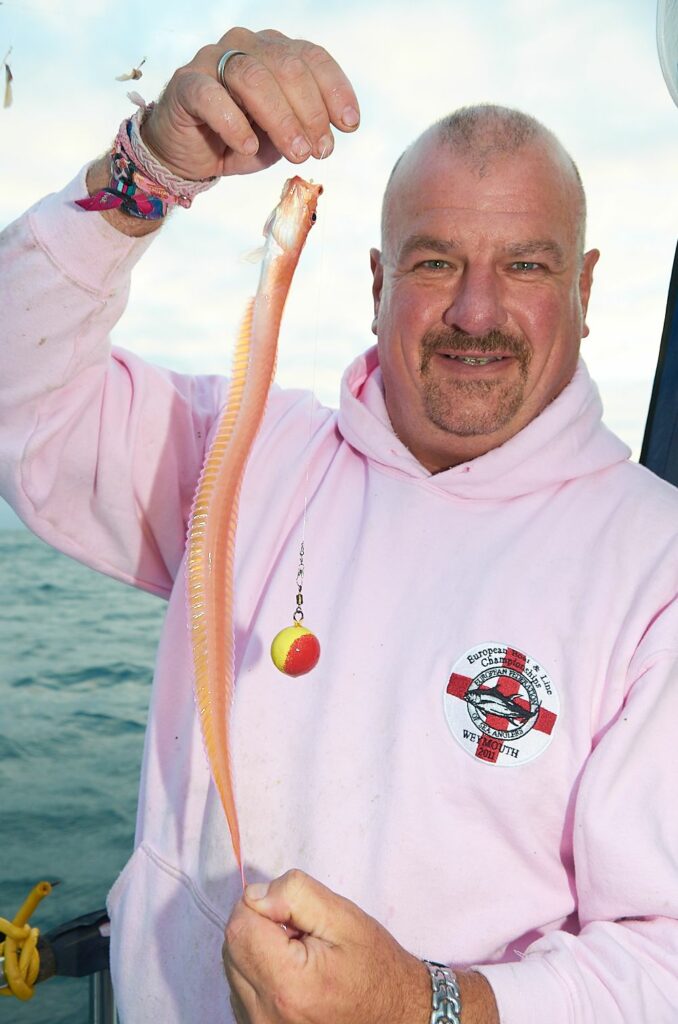
To give prospective anglers a heads up on good areas where colonies of red-band fish exist are off Weymouth, Plymouth Sound, ground well off from Lundy Island, off Anglesey and in the deeper Scottish sea lochs. In Ireland, less is known of their whereabouts, but there are clusters off Cobh in Co Cork, off Fenit, Co Kerry, and also inside Donegal Bay off Killybegs in Donegal.
Their overall distribution is not geographically uniform. They tend to be in colonies over ideal ground but then not found for some considerable distance. They live in vertical burrows in a thick mud or mud/sand bottom in depths from about 50-feet (this is rare, though) to 600-feet.
About the red band fish
Although not a rare fish regarding habitation in UK waters, the Red-Band Fish is rarely caught on rod and line unless you specifically target them. It’s a fish that is high on the species hunters list and therefore warrants a feature all on its own.Red band fish identification
There is little you can confuse the red-band fish with. It is eel-like in body shape. The body is long and slender but with a long dorsal fin originating above the gill cover and running all the way to the tail. The dorsal at the tail ends in a thin, almost hair-like wisp. The anal fin begins about the length of the head rear of the pectoral fin and again runs all the way to the tail. The eye is large. The mouth slants upwards and has fairly large, well-spaced teeth evident in both jaws.The colouration is distinctive, red or reddish-orange, with the belly having a noticeable yellowish tinge. The fins also have a yellowish colouring, except that the forward-facing part of the dorsal fin has more red in it.
The average length is around 14-inches, though much larger ones are not uncommon, and they can reach 28-inches in length.

Distribution
Red-band fish are found throughout the English Channel as far east as the Kent coast but are commonest in the southwest, throughout the Irish Sea as far as the northwest of Scotland. Also, all around the coast of Ireland. There is some evidence they are resident in the southern North Sea, but confirmation is hard to quantify.To give prospective anglers a heads up on good areas where colonies of red-band fish exist are off Weymouth, Plymouth Sound, ground well off from Lundy Island, off Anglesey and in the deeper Scottish sea lochs. In Ireland, less is known of their whereabouts, but there are clusters off Cobh in Co Cork, off Fenit, Co Kerry, and also inside Donegal Bay off Killybegs in Donegal.
Their overall distribution is not geographically uniform. They tend to be in colonies over ideal ground but then not found for some considerable distance. They live in vertical burrows in a thick mud or mud/sand bottom in depths from about 50-feet (this is rare, though) to 600-feet.
Diet
It feeds mostly on planktonic copepods, but the teeth suggest it is a predator too, capable of taking tiny fish, plus it will scavenge too, picking up items of food that have fallen to the seabed near its burrow. It feeds by poking its head and part of the upper body out of the burrow, and it “periscopes” the surrounding water and darts out to intercept food. It will occasionally leave the sanctuary of its home to wander a small distance away, but this is dictated by limited food resources.Boat Fishing for Red Band Fish
Boat fishing is the most common way to access the grounds where red-band fish live, but kayakers are often even better placed as they can access areas in out of the way places where the red band-fish colonies have never really been fished for. This especially applies to the Scottish sea lochs.
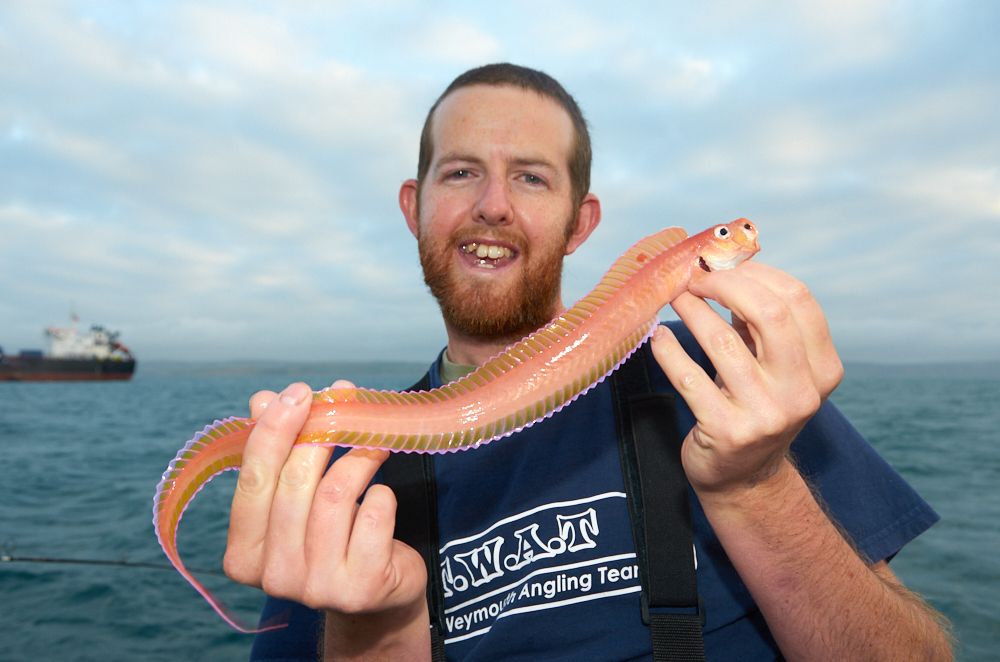
However, the late spring, summer, and autumn periods see the red-band fish a bit more active in their feeding. It suggests they may show the same trait as many other fish in building up food reserves for the winter period when food sources are less reliable.
We’ve also noticed that they sometimes lay within close range of small rocky outcrops, possibly because the outcrop may break the flow of the tide and make the ground more stable and less prone to seabed disruption.
Also, bear in mind the weather patterns before your trips. If the pattern has been for rough seas and heavy swells, especially if the water depth is less than 100-feet, then bear in mind that the seabed may have been churned up, and this can cause the fish to stay well buried in their burrows. More favourable conditions are when the sea and weather pattern has been calm and the barometric pressure fairly steady for a few days. These offer the optimum feeding conditions.
If you’re fishing in light tide areas inside harbours, or bays, then often a 2oz spinning rod, small 4000 sized fixed spool reel, and 20lb braid will be enough using weights no more than 4ozs. If this tackle allows you to get to the seabed and keep in contact with it, then it’s good enough. A 6lb class boat rod will also do a good job.
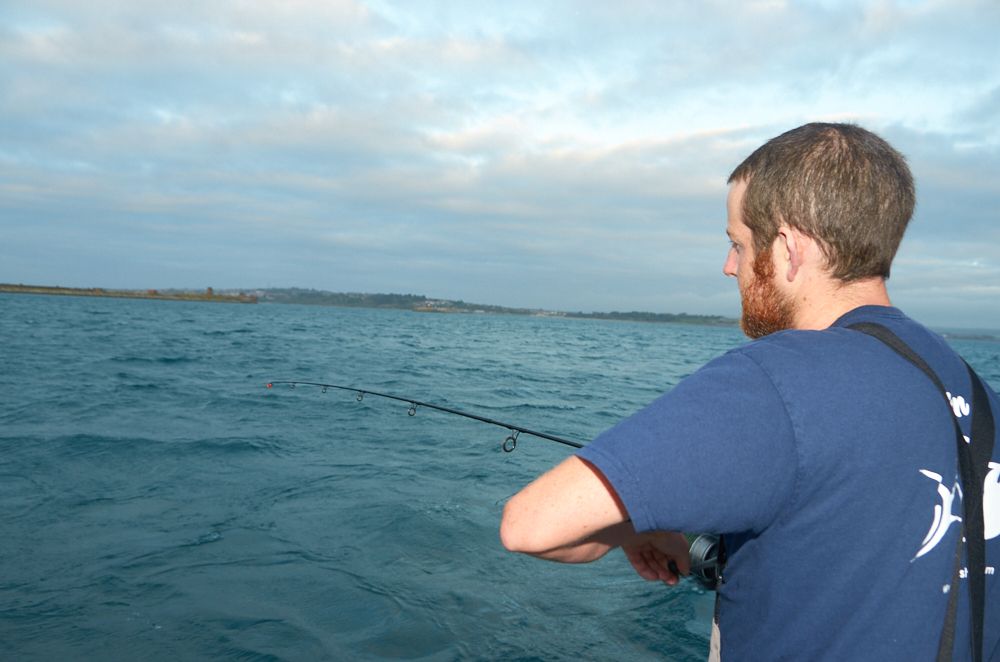
In deeper water and faster tides, when more lead weight is needed to get to the seabed, a 15lb class or 12/20lb class boat rod around 7ft 6in to 8ft is the only choice. The braid can stay the same at 20lbs.
Always use braid, never mono, as the bites can be delicate, and you’ll often miss the bites when using mono, especially in deep water. Equally, add a short section, about two lengths of the rod of fluorocarbon of the same breaking strain as the braid. The red-band fish has a big eye and good eyesight, so minimising the effect of the line in front of it, especially in shallower water, can help increase the catch.
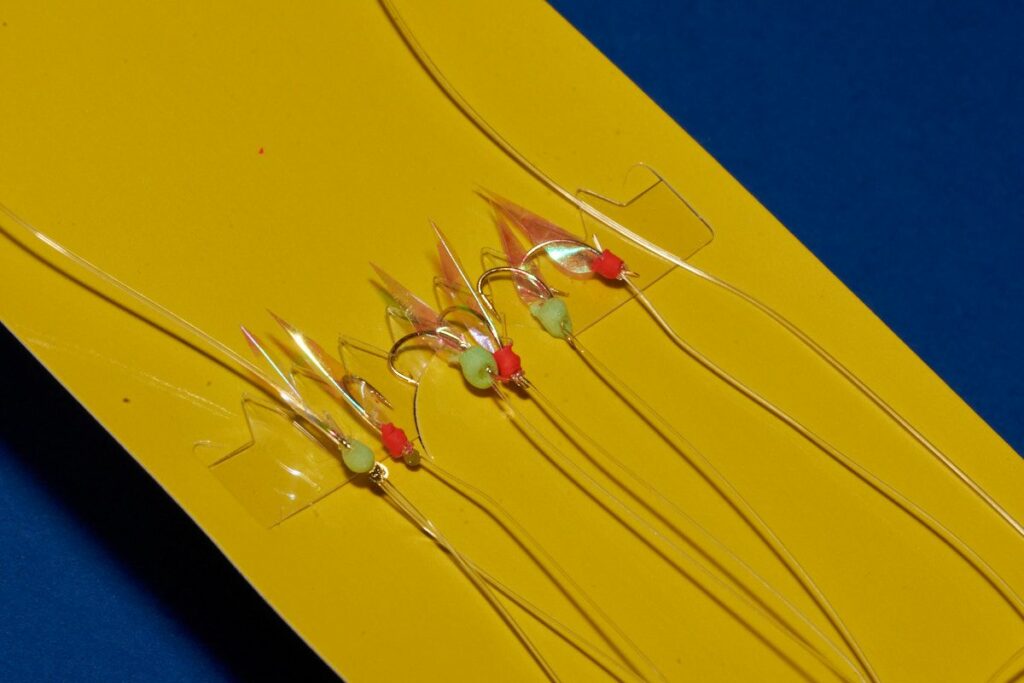
Alternatively, you can make a bait rig as follows that works well.
If you find all the fish are coming to the lower hook, shorten the bottom hook length to 6-inches and drop the higher hook length lower to get both baits in the feeding zone.
The very best bait is small slivers of mackerel or squid strip — these need to be no more than 10mm in length and cut very thin. We like to use the mackerel white belly skin section, but baits cut from the darker back section will work nearly as well.
Alternative baits are small chunks of ragworm, lugworm and maddie rag, though we find these less effective than the mackerel and squid strips. Herring and bluey strips can also work.
The 2-hook rig we built works much the same, but this rig having the longer hook lengths adds more movement when the boat is barely moving, and just drifting the baits over the burrows will catch you plenty of fish.
One major thing that helps is that you need to use as light a weight as you can get away with, one that just lets you keep in contact with the seabed, no more. The heavier weight you use, the less movement you tend to have, so always bear this in mind.
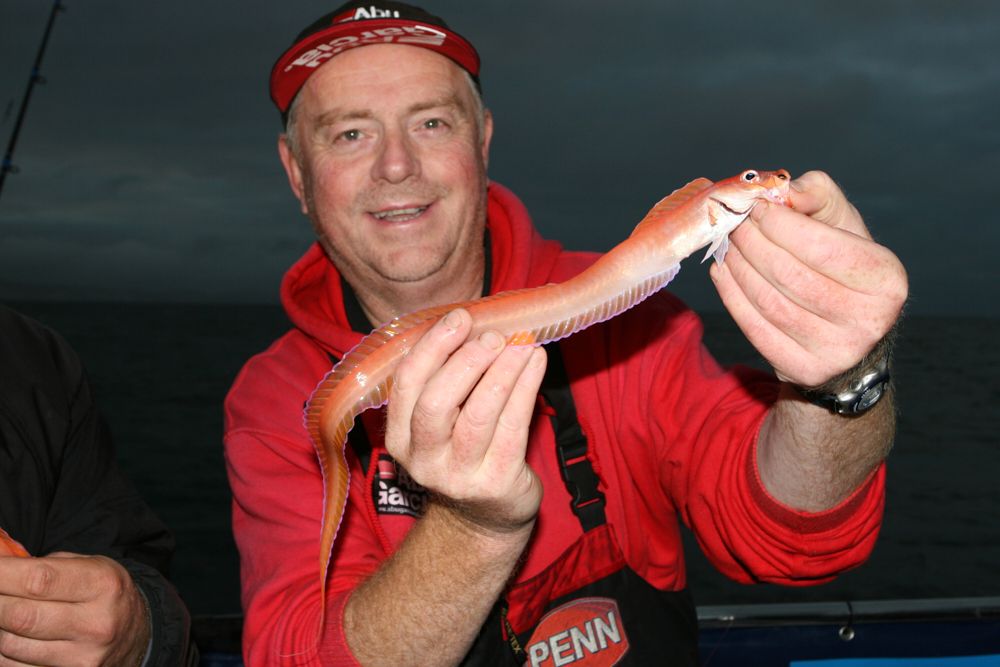

Season
If you checked catch returns, you’d assume that this species was a summer and autumnal only catch, but that’s mainly due to anglers targeting bigger fish with bigger baits during winter. They can be caught all year round if you use appropriate methods.However, the late spring, summer, and autumn periods see the red-band fish a bit more active in their feeding. It suggests they may show the same trait as many other fish in building up food reserves for the winter period when food sources are less reliable.
Habitat
As stated, they live over flat sandy bottoms if the sand is firm but mostly choose bottoms with a mainly mud mix as this is a consistent mass and enables the burrow to be more stable. They can cope with some tide run but generally choose areas just off the main tide run where the flow is lighter.We’ve also noticed that they sometimes lay within close range of small rocky outcrops, possibly because the outcrop may break the flow of the tide and make the ground more stable and less prone to seabed disruption.
Tides
If we were to pick a tide size to target red-band fish, we would choose a smaller neap tide. This is because the boat’s drift will be slower, giving you a longer time over the burrows. That’s not to say that bigger tides won’t produce as they can, but you’re then more dependent on the factors of getting calm weather with little or any wind or wind against tide conditions to reduce the boat drift speed over the ground, again to maximise time over the burrows and to give the red-band fish time to take the baits.Weather patterns
We haven’t found weather conditions make too much difference. Again, if we were picky, we’d go for a flat calm day with a light to moderate overcast sky. Brighter conditions, especially in shallower water, can make these fish less likely to feed.Also, bear in mind the weather patterns before your trips. If the pattern has been for rough seas and heavy swells, especially if the water depth is less than 100-feet, then bear in mind that the seabed may have been churned up, and this can cause the fish to stay well buried in their burrows. More favourable conditions are when the sea and weather pattern has been calm and the barometric pressure fairly steady for a few days. These offer the optimum feeding conditions.
Tackle for red band fish
It’s more the depth and the conditions that dictate the tackle you choose than the fish themselves.If you’re fishing in light tide areas inside harbours, or bays, then often a 2oz spinning rod, small 4000 sized fixed spool reel, and 20lb braid will be enough using weights no more than 4ozs. If this tackle allows you to get to the seabed and keep in contact with it, then it’s good enough. A 6lb class boat rod will also do a good job.

In deeper water and faster tides, when more lead weight is needed to get to the seabed, a 15lb class or 12/20lb class boat rod around 7ft 6in to 8ft is the only choice. The braid can stay the same at 20lbs.
Always use braid, never mono, as the bites can be delicate, and you’ll often miss the bites when using mono, especially in deep water. Equally, add a short section, about two lengths of the rod of fluorocarbon of the same breaking strain as the braid. The red-band fish has a big eye and good eyesight, so minimising the effect of the line in front of it, especially in shallower water, can help increase the catch.
Rigs
The most effective rig for targeting this species is a set of either gold or silver tinsel or luminous bodied feathers. They need to be small and tied on hooks no bigger than a size 8 with a size 10 or 12 being more appropriate. The Shakespeare Shrimp rigs are good, also the Tronixpro Sabiki rigs in the 12 hook size. Anything similar to these will also catch, but do make sure the overall body length of the lures is small, no more than 2cms and ideally half that.
Alternatively, you can make a bait rig as follows that works well.
- Take 20-inches of 20lb Fluorocarbon.
- At one end tie on a size 8 rolling swivel.
- Cut two 4mm lengths of neoprene tubing.
- Pass the free tag end of Fluorocarbon through a piece of tubing, bring it back over the top and go through the tubing a second time the same way. Now pull the line tight to close the tubing which will grip on the line but slide under pressure.
- Slide on a size 10 rolling swivel.
- Add another piece of tubing to lock the swivel in place.
- Repeat instruction no 4, 5 and 6 to form a second tubing and swivel assembly.
- To the free tag end, tie on a small lead link.
- The 8 to 10-inch hook lengths are tied to the size 10 swivels and need to be 12lb Fluorocarbon.
- The hooks need to be size 10 to 14, The Drennan Super Specialist being our favourite.
If you find all the fish are coming to the lower hook, shorten the bottom hook length to 6-inches and drop the higher hook length lower to get both baits in the feeding zone.
Baits
Even the small feather rigs need to be baited to be effective.The very best bait is small slivers of mackerel or squid strip — these need to be no more than 10mm in length and cut very thin. We like to use the mackerel white belly skin section, but baits cut from the darker back section will work nearly as well.
Alternative baits are small chunks of ragworm, lugworm and maddie rag, though we find these less effective than the mackerel and squid strips. Herring and bluey strips can also work.
Technique
The technique is very simple with the feathers. Drop the tackle to the seabed, and when over the burrows, just lift the rod tip a few inches occasionally to lift and drop the baits as the red-band fish respond better to a moving bait. You will also catch them just drifting the lead weight over the seabed if the boat drift is slow, but the occasional lift of the bait will make for more aggressive takes.The 2-hook rig we built works much the same, but this rig having the longer hook lengths adds more movement when the boat is barely moving, and just drifting the baits over the burrows will catch you plenty of fish.
One major thing that helps is that you need to use as light a weight as you can get away with, one that just lets you keep in contact with the seabed, no more. The heavier weight you use, the less movement you tend to have, so always bear this in mind.

Top tips for red band boat fishing
- In deep water, add one 2mm, small luminous green bead directly in front of the hooks on the 2-hook rig just to highlight the bait a bit more. Just one bead is enough, no more.
- If you find that you’re not getting bites on the 2-hook rig, change the hook lengths to a lighter breaking strain to improve the movement of the bait and reduce the line's visual impact.
- Avoid using larger luminous leads. While the red-band fish is attracted to luminous light in the water, this needs to be minimal and imitate plankton movement. A large-sized glowing lead weight seems to have the opposite effect and can put fish off even in deep water. Maybe they see it as a danger.
Shore Fishing for Red Band Fish
There is an official record for red-band fish off the shore at just over 7ozs taken way back in 2001, so it is possible to catch them off the shore. However, it’s likely to be a game of extreme patience and some long term planning but is probably not that difficult to achieve if you keep trying.
It’s no coincidence that the record is from a western Scottish loch where deep water is accessible directly off the shore. In our opinion, that’s where we’d be concentrating our efforts into one of the deeper Scottish sea lochs where you have a depth of more than 100-feet straight off the shoreline. Also, stick to the summer and autumn periods as we feel this offers you the best chance.
Apps like Navionics or paper charts for the area are the best places to start. Look for a mud or sandy, muddy bottom in that depth range of 100-feet or more within casting range of the shore. This puts you in the very best possible position. Stick to the smaller neap tides too, and fish braided lines to maximise bite detection. Also, try to pick out areas where the tide run is lessened, say inside an obvious bay or downtide of a rocky headland.
The same small feathers or luminous bodied lures are the best bet baiting with small slivers of mackerel strip. The 2-hook rig and small hooks is also worth a try, but the feathers may be best as some movement and the added attraction of the tinsel bodies will give you an edge over a natural but more static fished bait.
It’s no coincidence that the record is from a western Scottish loch where deep water is accessible directly off the shore. In our opinion, that’s where we’d be concentrating our efforts into one of the deeper Scottish sea lochs where you have a depth of more than 100-feet straight off the shoreline. Also, stick to the summer and autumn periods as we feel this offers you the best chance.
Apps like Navionics or paper charts for the area are the best places to start. Look for a mud or sandy, muddy bottom in that depth range of 100-feet or more within casting range of the shore. This puts you in the very best possible position. Stick to the smaller neap tides too, and fish braided lines to maximise bite detection. Also, try to pick out areas where the tide run is lessened, say inside an obvious bay or downtide of a rocky headland.
The same small feathers or luminous bodied lures are the best bet baiting with small slivers of mackerel strip. The 2-hook rig and small hooks is also worth a try, but the feathers may be best as some movement and the added attraction of the tinsel bodies will give you an edge over a natural but more static fished bait.

